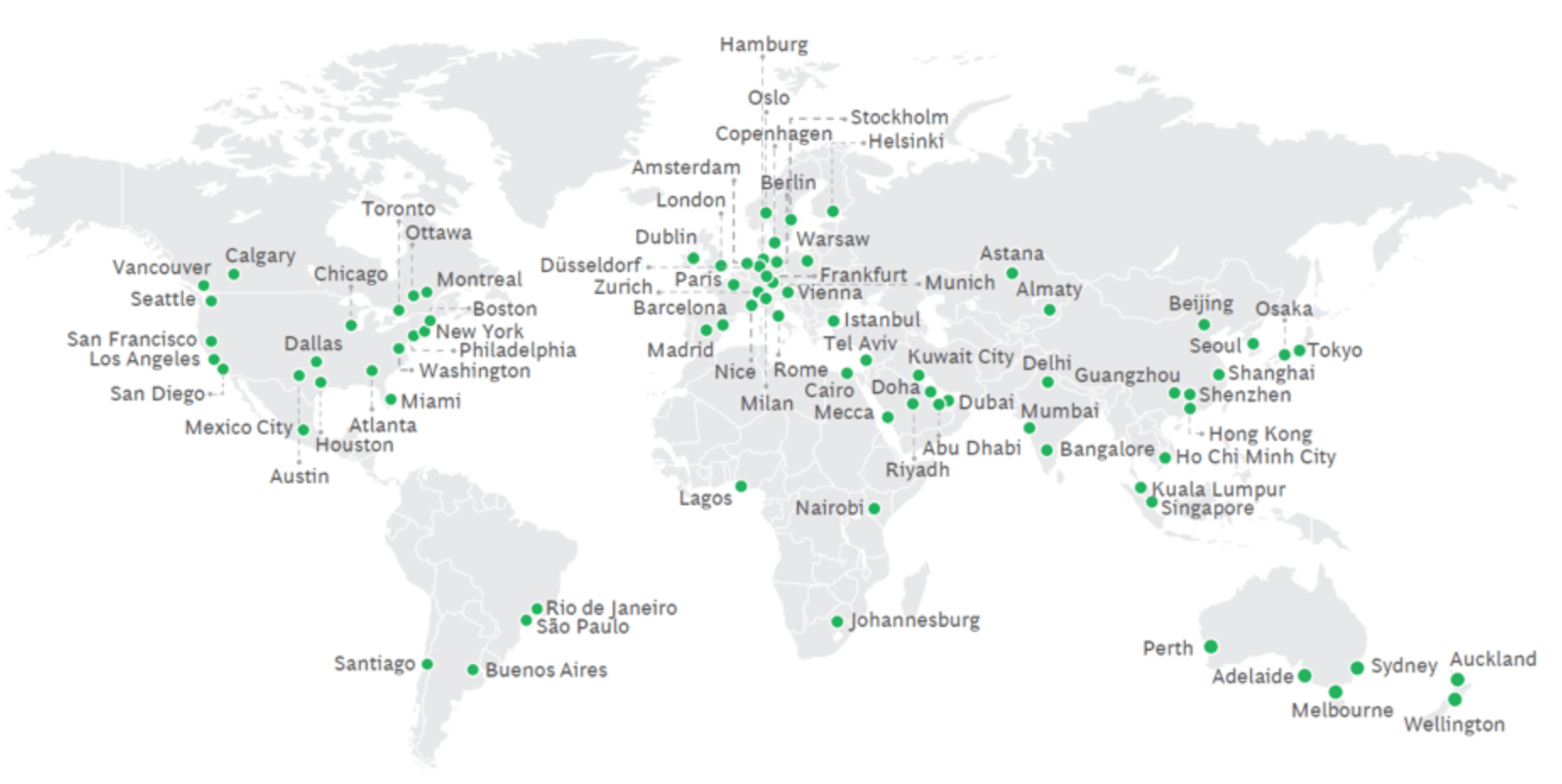Main Content
Blog
Blog Details
New Analysis Shows Which Cities Will Thrive In The Global Economy

Cities remain the key engines of the global economy even as new digital technologies have given people unprecedented choice in where we live and work. The world’s 300 largest cities or metro areas account for more than half of global economic output, while being home to just 20% of the world’s population. When it comes to innovation the pattern is even more startling: Just 24 global cities account for three-quarters of global venture capital investment while housing just four percent of the world’s population; and just the top six alone attract more than half of all global venture capital investment, despite housing just one percent of the world’s people. But by giving people more choice, the pandemic is upending the competition among global cities for investment, jobs, and talent. A new analysis enables us to better gauge the winners and losers of this competition and to assess which cities are best able to adapt to rapid change in the global economy and which are more challenged by it.
Superstar cites like London and New York continue to define the heights of this competition. But smaller European cities like Copenhagen, Vienna, and Amsterdam are becoming more attractive to mobile talent offering high quality of life at more affordable price points. American cities fare better than might be expected given their well-publicized challenges of homelessness, urban disorder, and vacant office corridors. San Francisco and Washington, D.C. join New York in the top ten, while Boston and Seattle number among the top 20 leading global cities. A deep divide separates the advanced cities of the Global North and the large cities of the Global South. While some fast-growing megacities in Asia and India show an ability to adapt to rapid change, too many megacities of the Global South continue to fall behind, and poor African cities fare worst of all.

These are some of the key takeaways of a comprehensive new ranking of global cities. It is based on a combination of detailed statistical data on more than 150 indicators of demographic, economic, social, and political factors, and unique survey data collected from more than 50,000 people in 79 leading global cities. The analysis spans five key categories: economic opportunity, quality of life, social capital, governance, and the pace of change. The ranking groups cities into four categories based on their population size and levels of economic development (or economic output per capita).
Megacenters are the world’s largest cities home to more than 10 million people. Cruiser weights are cities in the advanced world that are home more than 3 million people. Middleweights are also developed cities with populations of less than 3 million. Developing cities are cities of various sizes located in the emerging economies.
Ranking Global Cities of Choice
|
Overall rank |
City |
Total score |
Category |
|
1 |
London |
64.3 |
Megacenter |
|
2 |
New York |
64.3 |
Megacenter |
|
3 |
Washington DC |
64.2 |
Cruiserweight |
|
4 |
Singapore |
63.6 |
Cruiserweight |
|
5 |
Copenhagen |
63.4 |
Middleweight |
|
6 |
San Francisco |
62.2 |
Cruiserweight |
|
7 |
Vienna |
61.8 |
Middleweight |
|
8 |
Amsterdam |
61.0 |
Middleweight |
|
9 |
Warsaw |
60.9 |
Middleweight |
|
10 |
Shanghai |
60.1 |
Megacenter |
|
11 |
Guangzhou |
59.6 |
Cruiserweight |
|
12 |
Stockholm |
59.6 |
Middleweight |
|
13 |
Madrid |
58.1 |
Cruiserweight |
|
14 |
Munich |
58.1 |
Middleweight |
|
15 |
Zurich |
57.8 |
Middleweight |
|
16 |
Oslo |
57.8 |
Middleweight |
|
17 |
Abu Dhabi |
57.8 |
Middleweight |
|
18 |
Boston |
57.6 |
Cruiserweight |
|
19 |
Hamburg |
57.3 |
Middleweight |
|
20 |
Seattle |
57.2 |
Cruiserweight |
|
21 |
Dubai |
57.2 |
Cruiserweight |
|
22 |
Beijing |
57.1 |
Megacenter |
|
23 |
Wellington |
56.6 |
Middleweight |
|
24 |
Nice |
56.5 |
Middleweight |
|
25 |
Düsseldorf |
56.3 |
Middleweight |
|
26 |
Sydney |
56.2 |
Cruiserweight |
|
27 |
Atlanta |
56.1 |
Cruiserweight |
|
28 |
Los Angeles |
56.0 |
Megacenter |
|
29 |
Shenzhen |
55.9 |
Cruiserweight |
|
30 |
Berlin |
55.2 |
Cruiserweight |
|
31 |
Dublin |
55.1 |
Middleweight |
|
32 |
Frankfurt |
55.1 |
Middleweight |
|
33 |
Helsinki |
55.1 |
Middleweight |
|
34 |
Paris |
55.0 |
Megacenter |
|
35 |
Miami |
54.6 |
Cruiserweight |
Note: Highest possible score is 100.
The two top ranked cities overall are the megacenters of London and New York. These cities are superstars across many dimensions. They remain leaders in high-paying finance, management, knowledge, and creative industries and jobs and are magnets for world class talent. But their advantage is shrinking. They face growing pressure from expensive and unaffordable housing, long commutes, and the options that digitally enabled remote work has created in other less expensive global cities. Both cities rank low in their ability to adapt to the speed of change.
Smaller cities, both cruiserweights and middleweights, are coming up the ranks. Two cruiser weights, Washington, D.C. and Singapore, rank third and fourth with Copenhagen, a smaller middleweight, in fifth. Next in line is San Francisco, which may seem surprising given media reports of a city rife with homelessness and urban disorder and a downtown that has lagged on recovery. Despite these challenges, San Francisco appears to be bouncing back with increasing demand for office space from its burgeoning artificial intelligence clusters.
Rounding out the top ten are three middleweight cities, Vienna, Amsterdam, Warsaw, and a large megacenter, Shanghai. The remainder of the 20 includes four cruiserweights, Guangzhou, Madrid, Boston, and Seattle; and six smaller middleweights, Stockholm, Munich, Zurich, Oslo, Abu Dhabi, and Hamburg, and not a single megacenter. Cruiserweight and middleweight cities offer high quality of life, less congestion, and more affordable housing than megacenters. As a group, they score higher on factors such as cleanliness, income equality, safety, and overall resident satisfaction. On the flip side, they have smaller economies and offer less robust economic opportunities than the large megacenters of the advanced world.
The competition among global cities will define a good deal of our economic future. Superstar cites like London and New York continue to define the heights of global economic competition despite pandemic-era predictions of their imminent decline. But smaller cities in the advanced world are gaining ground based on their ability to offer high quality of life alongside more affordable housing. The advanced cities and those of the emerging economies are separated by a substantial economic divide. This divide goes beyond one of income and economic development. Too many of these cities, particularly those in Africa, continue to lag far behind on many dimensions of success. This is especially troubling since these are the cities that are expected to experience among the largest waves of urbanization in the future.
Text by RICHARD FLORIDA, VLADISLAV BOUTENKO, and ANTOINE VETRANO | Photo credit Unsplash | Read More Here



Login With
Or Sign Up With Disqus